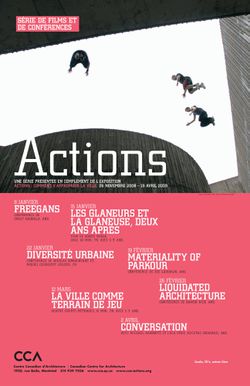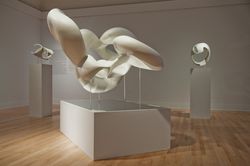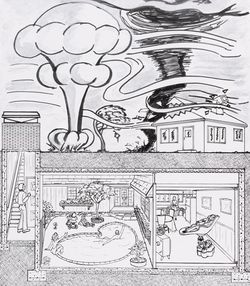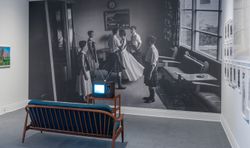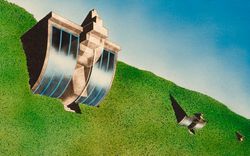dessins
AP148.S1.1970.PR02.001.6
Description:
Appear to be storyboard drawings, with each square advancing a narrative about the planet earth.
ca. 1970-1971
Sketches, Interplanetary Architecture (Folder 6 of 7)
Actions:
AP148.S1.1970.PR02.001.6
Description:
Appear to be storyboard drawings, with each square advancing a narrative about the planet earth.
dessins
ca. 1970-1971
Projet
AP207.S1.2013.PR01
Description:
The project series documents "The Game of Architecture", a drawing realized in 2013. The drawing is of triangular-shaped structures made of bricks standing in a desert. This drawing is a reinterpretation of a previous project by Pettena "Situazioni Competitive" in 1971. "Here architecture, albeit with the same characteristic of competitiveness, becomes indistinct, confused, no longer the leading actor, at the mercy of an unknown context (a desert? the nature of an alien planet?) which, threatening to overwhelm it, seems to nullify its every need and characteristic." [1] The project series contains a drawing for the 2013 edition and the 2018 version, which is a digital photograph modified to show the architectural construction standing in rough water. Source: [1] Gianni Pettena website, https://www.giannipettena.it/italiano/opere-1/nat-the-game-of-architecture-2013-1/ (last accessed 28 January 2020)
2011-2018
The Game of Architecture (2013)
Actions:
AP207.S1.2013.PR01
Description:
The project series documents "The Game of Architecture", a drawing realized in 2013. The drawing is of triangular-shaped structures made of bricks standing in a desert. This drawing is a reinterpretation of a previous project by Pettena "Situazioni Competitive" in 1971. "Here architecture, albeit with the same characteristic of competitiveness, becomes indistinct, confused, no longer the leading actor, at the mercy of an unknown context (a desert? the nature of an alien planet?) which, threatening to overwhelm it, seems to nullify its every need and characteristic." [1] The project series contains a drawing for the 2013 edition and the 2018 version, which is a digital photograph modified to show the architectural construction standing in rough water. Source: [1] Gianni Pettena website, https://www.giannipettena.it/italiano/opere-1/nat-the-game-of-architecture-2013-1/ (last accessed 28 January 2020)
Project
2011-2018
Projet
AP148.S1.1970.PR02
Description:
The project series documents Poli's work on the Interplanetary Architecture project, which was also made into a film by Superstudio directed by Alessandro Poli (the film is not included in the fonds). The project reflects Poli's deep fascination with the moon landing in 1969. Poli uses this major media event as a catalyst for thinking about a new approach to architecture and tools for design, including the idea that film and the movie camera should become part of the toolset. The project also seems to be in some way a response to Epoch magazine's challenge for a "Primo concorso di architettura nello spazio" (the first architectural competition in space), and includes much imagery and textual references to a new road or architectural links between the earth and other planets, including an earth moon highway. In his storyboard, Poli also makes reference to his earlier Piper project, and some imagery features wheels and an amusement park. The Interplanetary Architecture project was exhibited by Superstudio in Rome in 1972 and featured in "Casabella" magazine in April 1972 (no. 364). The project was also featured in the 2010 CCA exhibition "Other Space Odysseys". In the accompanying CCA publication, Poli describes this project as "a voyage off earthbound routes in quest of architecture unfettered by the urban nightmare, by induced needs or by planning as the only tool for regulating and solving the world's problems" (Poli quoted in Borasi and Zardini, 2010, 110). Poli's work on this project is deeply tied to the Zeno project, which was also featured in this exhibition and is included in this fonds (see AP148.S1.1972.PR01). For the Zeno project, Poli envisioned a dialogue between astronaut Buzz Aldrin and an Italian peasant, Zeno of Riparbella. Poli felt that these two shared a similarity in that both their homes were isolated capsules, one that provided a lens from which to see the rest of the world and understand their place in it. The material in the series includes numerous photomontages and collages of astronauts in space, as well as drawings of plantery shapes and structures. There are also texts, some of which include calculations of distances and diameters of planets, as well as notebooks and sketchbooks, many of which Poli included in a folder he entitled "Storyboard." The series also includes an unsent letter from Poli to Adolfo Natalini which describes how, after the moon landing, everything - the planet, the moon, the stars - is architecture, and that this will necessitate the need for new design tools, such as the movie camera. Some works are signed Alessandro Poli-Superstudio. Source cited: Giovanna Borasi and Mirko Zardini, eds., Other Space Odysseys, Montreal and Baden: Canadian Centre for Architecture/Lars Müller Publishers, 2010.
1969-1971
Architettura Interplanetaria [Interplanetary Architecture] (1970-1971)
Actions:
AP148.S1.1970.PR02
Description:
The project series documents Poli's work on the Interplanetary Architecture project, which was also made into a film by Superstudio directed by Alessandro Poli (the film is not included in the fonds). The project reflects Poli's deep fascination with the moon landing in 1969. Poli uses this major media event as a catalyst for thinking about a new approach to architecture and tools for design, including the idea that film and the movie camera should become part of the toolset. The project also seems to be in some way a response to Epoch magazine's challenge for a "Primo concorso di architettura nello spazio" (the first architectural competition in space), and includes much imagery and textual references to a new road or architectural links between the earth and other planets, including an earth moon highway. In his storyboard, Poli also makes reference to his earlier Piper project, and some imagery features wheels and an amusement park. The Interplanetary Architecture project was exhibited by Superstudio in Rome in 1972 and featured in "Casabella" magazine in April 1972 (no. 364). The project was also featured in the 2010 CCA exhibition "Other Space Odysseys". In the accompanying CCA publication, Poli describes this project as "a voyage off earthbound routes in quest of architecture unfettered by the urban nightmare, by induced needs or by planning as the only tool for regulating and solving the world's problems" (Poli quoted in Borasi and Zardini, 2010, 110). Poli's work on this project is deeply tied to the Zeno project, which was also featured in this exhibition and is included in this fonds (see AP148.S1.1972.PR01). For the Zeno project, Poli envisioned a dialogue between astronaut Buzz Aldrin and an Italian peasant, Zeno of Riparbella. Poli felt that these two shared a similarity in that both their homes were isolated capsules, one that provided a lens from which to see the rest of the world and understand their place in it. The material in the series includes numerous photomontages and collages of astronauts in space, as well as drawings of plantery shapes and structures. There are also texts, some of which include calculations of distances and diameters of planets, as well as notebooks and sketchbooks, many of which Poli included in a folder he entitled "Storyboard." The series also includes an unsent letter from Poli to Adolfo Natalini which describes how, after the moon landing, everything - the planet, the moon, the stars - is architecture, and that this will necessitate the need for new design tools, such as the movie camera. Some works are signed Alessandro Poli-Superstudio. Source cited: Giovanna Borasi and Mirko Zardini, eds., Other Space Odysseys, Montreal and Baden: Canadian Centre for Architecture/Lars Müller Publishers, 2010.
Project
1969-1971
Diversité urbaine
Deux représentants du collectif français Coloco, l’architecte Nicolas Bonnenfant et le paysagiste Miguel Georgieff, présentent leur projet « Habiter des squelettes » qui consiste à repérer et à reconvertir des structures abandonnées, véritables « squelettes urbains ». Leur projet redéfinit la notion d’auto-construction et y accole celle de gestion de la durée de vie des(...)
Théâtre Paul-Desmarais
22 janvier 2009
Diversité urbaine
Actions:
Description:
Deux représentants du collectif français Coloco, l’architecte Nicolas Bonnenfant et le paysagiste Miguel Georgieff, présentent leur projet « Habiter des squelettes » qui consiste à repérer et à reconvertir des structures abandonnées, véritables « squelettes urbains ». Leur projet redéfinit la notion d’auto-construction et y accole celle de gestion de la durée de vie des(...)
Théâtre Paul-Desmarais
Autres odyssées de l’espace expose trois perspectives sur une aventure entamée il y a 40 ans, après la mission lunaire de 1969. Présentant les travaux des architectes Greg Lynn, Michael Maltzan et Alessandro Poli, Autres odyssées de l’espace se tient à un moment où l’exploration spatiale fait l’objet d’un engouement renouvelé, mais aussi de questionnements quant à sa(...)
Salles principales
8 avril 2010 au 19 septembre 2010
Autres odyssées de l’espace : Greg Lynn, Michael Maltzan, Alessandro Poli
Actions:
Description:
Autres odyssées de l’espace expose trois perspectives sur une aventure entamée il y a 40 ans, après la mission lunaire de 1969. Présentant les travaux des architectes Greg Lynn, Michael Maltzan et Alessandro Poli, Autres odyssées de l’espace se tient à un moment où l’exploration spatiale fait l’objet d’un engouement renouvelé, mais aussi de questionnements quant à sa(...)
Salles principales
dessins
AP148.S1.1970.PR02.006
Description:
Drawings of planets and other structures. Possibly a copy of other storyboard drawings by Poli.
ca. 1970-1971
Planetary drawings, Interplanetary Architecture
Actions:
AP148.S1.1970.PR02.006
Description:
Drawings of planets and other structures. Possibly a copy of other storyboard drawings by Poli.
dessins
ca. 1970-1971
Venez entendre les boursiers CCA-WRI 2023 Andrea Alberto Dutto, Oxana Gourinovitch et Tomomi Miyata qui nous présentent leurs recherches sur l’évolution de la notion de sous-sol – d’espace angoissant du temps de la Guerre froide et d’extraction de ressources aux préoccupations actuelles sur le climat et autres désastres transnationaux pour lesquels la terre peut servir de refuge.
En ligne Mot(s)-clé(s):
Andrea Alberto Dutto, Oxana Gourinovitch, Tomomi Miyata, Yoshiharu Tsukamoto, Jungyoon Kim, WRI, lumière, planète
10 août 2023, 9 h à 12 h
Angoisses souterraines : colloque de recherche CCA-WRI 2023
Actions:
Description:
Venez entendre les boursiers CCA-WRI 2023 Andrea Alberto Dutto, Oxana Gourinovitch et Tomomi Miyata qui nous présentent leurs recherches sur l’évolution de la notion de sous-sol – d’espace angoissant du temps de la Guerre froide et d’extraction de ressources aux préoccupations actuelles sur le climat et autres désastres transnationaux pour lesquels la terre peut servir de refuge.
En ligne Mot(s)-clé(s):
Andrea Alberto Dutto, Oxana Gourinovitch, Tomomi Miyata, Yoshiharu Tsukamoto, Jungyoon Kim, WRI, lumière, planète
recherche
Chercheurs CCA-WRI 2022
Programme de bourses de recherche CCA-WRI 2022
Casper Laing Ebbensgaard, Alina Nazmeeva, Jessica Vaughn, Yoshiharu Tsukamoto, Gökçe Günel, WRI, lumière, planète
1 juillet 2022 au 30 septembre 2022
recherche
1 juillet 2022 au
30 septembre 2022
Casper Laing Ebbensgaard, Alina Nazmeeva, Jessica Vaughn, Yoshiharu Tsukamoto, Gökçe Günel, WRI, lumière, planète
À une époque où l’empreinte de l’homme sur la planète atteint un niveau inégalé, certains pays se distinguent par leur situation enviable et la complexité de leur relation au territoire. Les histoires entourant le Canada sont intimement liées à la découverte et à l’appropriation de ressources naturelles à la fois importantes et diversifiées, ainsi qu’à des points de vue(...)
16 novembre 2016 au 9 avril 2017
Le temps presse
Actions:
Description:
À une époque où l’empreinte de l’homme sur la planète atteint un niveau inégalé, certains pays se distinguent par leur situation enviable et la complexité de leur relation au territoire. Les histoires entourant le Canada sont intimement liées à la découverte et à l’appropriation de ressources naturelles à la fois importantes et diversifiées, ainsi qu’à des points de vue(...)
articles
Using the Earth for Shelter
Notre client, la planète
